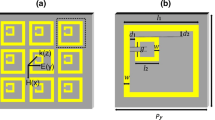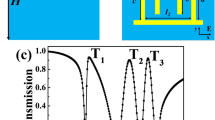Abstract
We propose a dual-band transparent window terahertz metamaterial consisting of a closed-ring resonator and a square patch. This structure can achieve two transparent windows with transmission intensity of more than 90%. The formation of the two windows can be attributed to the coupling of the localized resonance modes between the closed-ring and square patch. The influence of the geometrical dimensions of the closed-ring resonator and the square patch on the transmitted spectrum is also discussed; it is found that the change of sizes can strongly affect the frequencies of the two transparent windows. This novel terahertz metamaterial may open up new avenues toward the control of terahertz waves in many technology-related areas.






Similar content being viewed by others
References
Lahiri B, Mcmeekin SG, Khokhar AZ, Rue RMDL, Johnson NP (2010) Magnetic response of split ring resonators (SRRs) at visible frequencies. Opt Express 18:3210–3218
Zhang J, Xiong LI, Zhang T, Zhao Z, Luo X (2016) Tunable THz filter based on double split-ring resonator with flexible cantilever. Opto-Electron Eng 43:77–81
Zhang S, Fan W, Panoiu NC, Malloy KJ, Osgood RM, Brueck SR (2006) Optical negative-index bulk metamaterials consisting of 2D perforated metal-dielectric stacks. Opt Express 14:6778–6787
Plum E, Zhou J, Dong J, Fedotov VA, Koschny T, Soukoulis CM, Zheludev NI (2009) Negative refractive index due to chirality. Phys Rev B 79:035407
Liu N, Liu H, Zhu S, Giessen H (2009) Stereometamaterials. Nat Photonics 3:157–162
Liu N, Weiss T, Mesch M, Langguth L, Eigenthaler U, Hirscher M (2010) Planar metamaterial analogue of electromagnetically induced transparency for plasmonic sensing. Nano Lett 10:1103–1107
Longdell JJ, Fraval E, Sellars MJ (2005) Stopped light with storage times greater than 1 second using EIT in a solid. Phys Rev Lett 95:063601
Totsuka K, Kobayashi N, Tomita M (2007) Slow light in coupled-resonator-induced transparency. Phys Rev Lett 98:213904
Yanik MF, Suh W, Wang Z, Fan S (2004) Stopping light in a waveguide with an all-optical analog of electromagnetically induced transparency. Phys Rev Lett 93:233903
Zhang XQ, Li Q, Cao W, Gu JQ, Singh RJ, Tian Z, Han JG, Zhang WL (2013) Polarization-independent plasmon-induced transparency in a fourfold symmetric terahertz metamaterial. IEEE J Select Top Quantun Electron 19:8400707
Zhang S, Genov DA, Wang Y, Liu M, Zhang X (2008) Plasmoninduced transparency in metamaterials. Phys Rev Lett 101:047401
Papasimakis N, Fedotov VA, Zheludev NI, Prosvirnin SL (2008) Metamaterial analog of electromagnetically induced transparency. Phys Rev Lett 101:253903
Singh R, Rockstuh C, Lederer F, Zhang W (2009) Coupling between a dark and a bright eigenmode in a terahertz metamaterial. Phys Rev B 79:085111
Tassin P, Zhang L, Koschny T, Economou EN, Souboulis CM (2009) Low-loss metamaterials based on classical electromagnetically induced transparency. Phys Rev Lett 102:053901
Liu N, Langguth L, Weiss T, Kästel J, Fleischhauer M, Pfau T, Giessen H (2009) Plasmonic analogue of electromagnetically induced transparency at the Drude damping limit. Nat Mater 8:758–762
Liao CL, Fu GL, Xia SX, Li HJ, Zhai X, Wang LL (2018) Tunable plasmon-induced transparency based on graphene nanoring coupling with graphene nanostrips. J Mod Opt 65:1–7
Habib M, RRashed A, Ozbay E, Caglayan H (2018) Graphene-based tunable plasmon induced transparency in gold strips. Opt Mater Express 8:1069–1074
Devi KM, Islam M, Chowdhury DR, Sarma AK, Kumar G (2017) Plasmon induced transparency in graphene based terahertz metamaterials. Europhys Lett 120:27005
Wang ZJ, Guo SH, Li JJ, Wang FY (2014) Dual-band terahertz filters with sharp slope rate of edge based on two-layered composite metamaterial. J Chem Pharm Res 6:96–100
Yen TJ (2011) A high-transmission dualband terahertz bandpass filter by exciting multiresonance of metamaterials. Proceedings of SPIE 8070:80700V
Bernussi AA, Holtz M, Saed M, Vegesna S, Kuryatkov V (2013) Tunable dual-band terahertz metamaterial bandpass filters. Opt Lett 38:2382–2384
Drysdale TD, Gregory IS, Baker C, Linfield EH, Tribe WR (2004) Transmittance of a tunable filter at terahertz frequencies. Appl Phys Lett 85:5173–5175
Fang N, Lee H, Sun C, Zhang X (2005) Sub-diffraction-limited optical imaging with a silver superlens. Science 308:534–537
Yahiaoui R, Strikwerda AC, Jepsen PU (2016) Terahertz plasmonic structure with enhanced sensing capabilities. IEEE Sensors J 16:2484–2488
Cong L, Tan S, Yahiaoui R, Yan F, Zhang W, Singh R (2015) Experimental demonstration of ultrasensitive sensing with terahertz metamaterial absorbers: a comparison with the metasurfaces. Appl Phys Lett 106:031107
Schurig D, Mock JJ, Justice BJ, Cummer SA, Pendry JB, Starr AF, Smith DR (2006) Metamaterial electromagnetic cloak at microwave frequencies. Science 314:977–980
Yahiaoui R, Hanai K, Takano K, Nishida T, Miya-maru F, Nakajima M, Hangyo M (2015) Trapping waves with terahertz metamaterial absorber based on isotropic Mie resonators. Opt Lett 40:3197–3200
Yahiaoui R, Ouslimani HH (2017) Broadband polarization-independent wide-angle and reconfigurable phase transition hybrid metamaterial absorber. J Appl Phys 122:093104
Na L, Giessen H (2015) Coupling effects in optical metamaterials. Angew Chem Int Ed 49:9838–9852
Na L, Kaiser S, Giesse H (2010) Magnetoinductive and electroinductive coupling in plasmonic metamaterial molecules. Adv Mater 20:4521–4525
Funding
This work was supported in part by the National Natural Science Foundation of China under Grant 11647143, in part by the Natural Science Foundation of Jiangsu Province under Grant BK20160189, and in part by the Fundamental Research Funds for the Central Universities under Grant JUSRP51721B.
Author information
Authors and Affiliations
Corresponding author
Rights and permissions
About this article
Cite this article
Tang, C., Niu, Q., Wang, BX. et al. Design of Dual-Band Plasmon-Induced Transparent Effect Based on Composite Structure of Closed-Ring and Square Patch. Plasmonics 14, 533–538 (2019). https://doi.org/10.1007/s11468-018-0831-2
Received:
Accepted:
Published:
Issue Date:
DOI: https://doi.org/10.1007/s11468-018-0831-2




